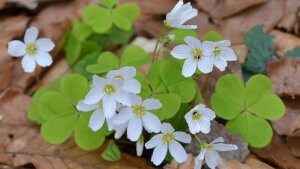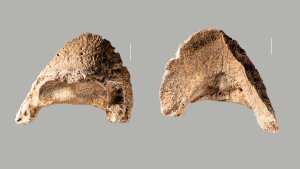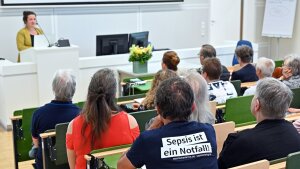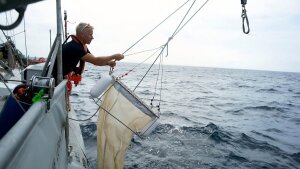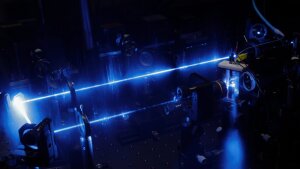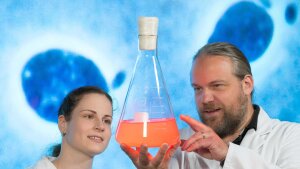Ticker
Dr Barbara Schmidt with an electric hand dynamometer in front of Jena University Hospital
Image: UKJHow mental training works
Dr Barbara Schmidt (pictured), a psychologist at Jena University Hospital (JUH), has examined the influence of hypnosis on physical strength and published her study in »Scientific Reports« (DOI: 10.1038/s41598-024-73117-0External link).
In the course of her work, Schmidt was able to demonstrate that hypnosis can increase both the subjective feeling of strength and objectively measurable strength—with lasting effect, including one week after hypnosis. Barbara Schmidt conducted tests on professional biathletes at the Olympic training centre in the Black Forest. The insights gained in her research have ramifications for high-performance sport and for patient recovery processes. [Bogner]
Wood sorrel (Oxalis acetosella) surrounded by brown leaves
Image: Petr HarantGo west
The distribution of European forest plants is shifting westward— and the primary cause is nitrogen input. These are the findings of a study published in »Science« (DOI:10.1126/science.ado0878External link) involving three researchers from the German Centre for Integrative Biodiversity Research (iDiv), including Prof. Dr Markus Bernhardt-Römermann of the University of Jena. The sorrel species Oxalis acetosella is creeping westward at a rate of 5 km per year and northward by around 0.1 km per year.
These results contradict the assumption that climate change is the primary cause of the displacement in species distribution, casting new light on the issue of how environmental factors are influencing species diversity. [Hahn]
Horse toe bones excavated near Saalfeld with cut marks made by flint knives
Image: W. MüllerBones from the Palaeolithic Age
A team of researchers from the University of Jena and the University of Neuchâtel, including Jena-based pre-historian Prof. Dr Clemens Pasda, has re-examined bones from the Palaeolithic Age excavated in the 1970s near Saalfeld. They include equine phalangeal bones with crop marks from a flint blade.
The artefacts date back to the Magdalenians—a culture that originated roughly 20,000 years ago and endured for around 6,000 years. The researchers’ newly gleaned insights support the theory that people in those times did not live in larger camps from which they launched hunting expeditions before returning, and instead wandered in small, mobile groups, following the tracks of their next prey (DOI: 10.7485/qu.2023.70.108128External link). [sh]
Participants at the final meeting of the Central German Sepsis Cohort at Jena University Hospital
Image: Michael SzabóLong-term effects of sepsis
Since 2016, a team led by Prof. Dr André Scherag at Jena University Hospital (JUH) has surveyed over 3,000 sepsis survivors, collecting data on the state of their health. Their findings have now been published in »The Lancet Regional Health—Europe« (DOI: 10.1016/j.lanepe.2024.101066External link).
The study verifies the urgent need for interdisciplinary after-care services. Almost all sepsis survivors experienced secondary diseases, with 90% reporting some form of physical limitation. Six in every ten survivors complained of memory issues, while four in ten experienced psychological after-effects. Many survivors suffered from multiple secondary diseases simultaneously. Patients who previously lived independently have good prospects of retaining this independence. Overall, however, only around one third of sepsis survivors regain their independence. [vdG]
A crew member of the research vessel »Tara« collects unicellular microalgae from the sea.
Image: Samues Bollendorff/Fondation Tara OcéanForever young
A team in the Cluster of Excellence »Balance of the Microverse«, led by Dr Yun Deng and Prof. Dr Georg Pohnert of the Institute of Inorganic and Analytical Chemistry, has discovered a rejuvenation mechanism in single-celled organisms. The researchers examined microalgae, which serve as the basis of oceanic food webs.
Single-celled organisms age if a lack of nutrients renders them unable to perform cell division. The newly discovered mechanism enables old cells to rejuvenate and divide again after reaching nutrient-rich areas. The researchers’ findings could have far-reaching implications for our understanding of cell ageing and regeneration in marine ecosystems. The study has been published in »Nature Microbiology« (DOI: 10.1038/s41564-024-01746-2External link). [Seeber]
A laser setup at the Leibniz Institute of Photonic Technology
Image: Sven DöringFundamentals of sustainable energy
Researchers in Jena and Ulm have developed an approach by which to influence the properties of materials known as chromophores. These are molecules than can absorb light and emit the stored energy, for example through electron transfer. Chromophores’ ability to absorb light and then transfer electrons to a reactant is hugely relevant, especially for photocatalysis and photovoltaics.
The research team led by Prof. Dr Benjamin Dietzek-Ivanšić of the »CataLight« Collaborative Research Centre experimented with iron compounds to demonstrate the ability to control material properties through chemical modifications. The study has been published in the »Journal of the American Chemical Society« (DOI:10.1021/jacs.4c00552External link). [Meier-Ewert]
Artistic visualization: Transformation of light properties through 2D meta-materials
Illustration: Christian Süß/Fraunhofer-IOFBreakthrough in quantum optics
An international research team headed up by Maximilian Weißflog of the Institute of Applied Physics has taken a significant step forward in quantum optics. In an article featured in »Nature Communications«, the team outlines a novel method to produce entangled photon pairs with the help of two-dimensional (2D) materials (DOI: 10.1038/s41467-024-51843-3External link).
This development could throw open the door to quantum encryption on mobile devices. The entangled photon-pair source detailed in the report is remarkably small: at just 10 x 10 x 10 micrometres (μm), it could easily be integrated into compact devices. This represents a decisive advantage over conventional sources of entangled photons, which are often bulky and require complex handling. [Winkler]
Prof. Dr Christian Jogler and doctoral student Carmen Elisabeth Wurzbacher with an Erlenmeyer flask containing the bacterium Planctopirus Limnophila
Image: Jens Meyer (University of Jena)Bacteria on the prowl
A research team spearheaded by Prof. Dr Christian Jogler (pictured, right) has discovered single-celled organisms that established doctrine says should not even exist. In an article published in »mBio«, the researchers demonstrate that the prokaryotic bacterium Uabimicrobium helgolandensis is capable of »eating« other unicellular organisms (DOI: 10.1128/mbio.02044-24External link).
The outcome of this endocytosis is a composite organism comprised of two prokaryotic cells, which could be regarded as a sort of precursor to eukaryotic cells in higher organisms. The team’s findings have, therefore, disproved the doctrine that it is energetically impossible for prokaryotic cells to be capable of endocytosis. Unlike eukaryotic cells, which possess a cell nucleus and mitochondria that provide them with energy, prokaryotes lack a »cellular power plant«. [MK]

